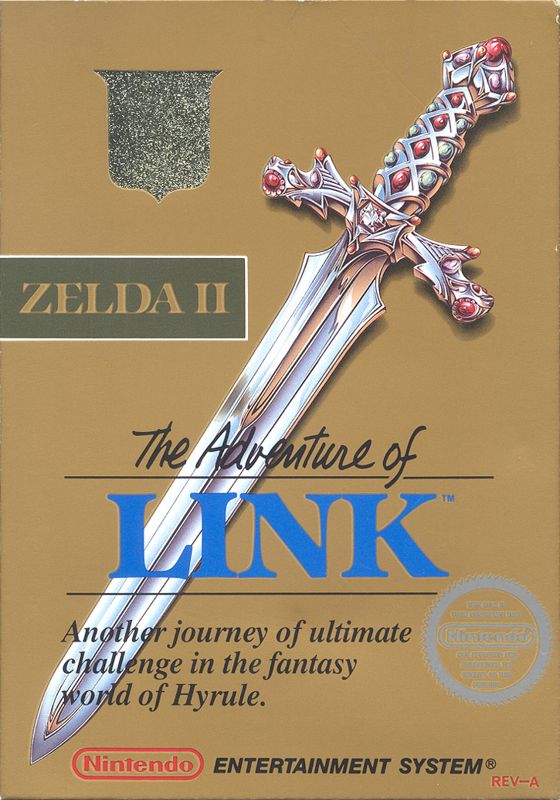Retro Replay Review
Gameplay
Zelda II: The Adventure of Link marks a bold departure from its predecessor by blending top-down exploration with side-scrolling action-RPG mechanics. When traversing the overworld of Hyrule, Link moves in a classic top-down perspective, where strategic movement and map awareness are vital. Once Link steps into combat zones, temples, or towns, the view switches to a side-scrolling format that emphasizes precise timing, platforming skills, and reflexive swordplay.
The game introduces a robust experience and leveling system unheard of in the first Legend of Zelda. Enemies defeated in the wilderness or temples yield experience points, which you can spend to increase your magic capacity, life containers, or attack power. This customization allows players to tailor Link’s growth to their preferred playstyle—whether that’s maximizing raw damage for sword combat or investing in magic to cast spells like Shield, Jump, or Fire.
Spells play a crucial role in both offense and defense. Each spell consumes magic points, forcing you to balance aggressive tactics with resource conservation. Magic jars and blue-red jars left behind by foes become vital pickups during challenging dungeon runs. Managing Link’s health and magic meter, combined with the risk-reward of vertical platforming sections and boss battles, makes every expedition into a temple a tense and rewarding affair.
Adding depth to the gameplay is the battery backup feature, which allows you to save your progress at inns and shrines—no more relying on lengthy password strings. This convenience complements the game’s often punishing difficulty, as you can return to the action without retracing every step from the world map. Overall, the gameplay loop of exploration, leveling, and side-scrolling combat offers a rich, if challenging, experience.
Graphics
On the Nintendo Entertainment System, Zelda II showcases one of the more detailed palettes of its era. The overworld’s green plains, brown mountains, and winding waterways are clearly rendered, giving Hyrule a distinctive and memorable identity. Character sprites for Link and the various townsfolk and monsters are surprisingly expressive given the hardware constraints.
Switching to the side-scrolling perspective, the pixel art remains crisp and well-animated. Link’s jump arc, sword swings, and spell-casting animations all feel responsive, with minimal flicker or slowdown—an impressive technical feat for a game of its scale. Backgrounds in temples and caves feature modest parallax effects, adding a sense of depth that enhances the atmosphere of each dungeon.
Enemy design deserves special mention: from the spindly Iron Knuckles to the flying Wizzrobes, each foe is distinct in silhouette and movement patterns. Boss encounters, like the heads of Moldorm or the hulking Thunderbird, are suitably large and imposing. While the color palette is limited, clever use of contrasting hues ensures that Link, his equipment, and enemies always stand out clearly against their environments.
Though it lacks the vibrant color range of later 16-bit titles, Zelda II’s graphics harness the NES’s capabilities to deliver a visually coherent world. The game’s aesthetic still holds nostalgic charm, and its artistic choices effectively convey both the grand scale of Hyrule’s overworld and the oppressive gloom of its temples.
Story
In Zelda II: The Adventure of Link, the stakes are higher and more personal than ever before. Link, now sixteen, discovers a mysterious birthmark on his hand. Guided by Impa, Princess Zelda’s loyal nursemaid, he learns that this mark is the key to the chamber where Zelda lies under an eternal slumber. The backstory reveals a tragic attempt by a power-hungry magician to extract Triforce secrets from the princess, resulting in her cursed sleep.
The narrative deepens with the lore of the Triforce of Power. Zelda once held its knowledge, and when the magician fell short, the prince of Hyrule created a perennial memorial: every royal female child would carry the name Zelda. With Ganon’s minions growing in strength and rumors that sprinkling Link’s blood on Ganon’s ashes could resurrect the dark lord, the journey to collect all Triforce fragments becomes urgent.
Each temple serves as a narrative milestone. Defeating its guardian monster not only unlocks a Triforce piece but also unravels more of Hyrule’s history—and Link’s destiny. Towns and non-playable characters, though limited in dialogue, provide side quests and healing services that flesh out the world. The sense of progression, from humble villages to foreboding dungeons, keeps the story compelling.
While the plot is simpler compared to modern standards, its mythic tone and high stakes—saving a sleeping princess and preventing the return of Ganon—resonate strongly. The mixture of personal motivation and epic legend makes Zelda II’s narrative both memorable and motivating for players to press onward.
Overall Experience
Zelda II: The Adventure of Link remains a standout title in Nintendo’s storied franchise for its ambitious blend of RPG mechanics and side-scrolling action. The learning curve is steep, especially for newcomers accustomed to the more straightforward original. However, the satisfaction of leveling Link’s stats, mastering new spells, and overcoming tough bosses yields a profound sense of accomplishment.
The game’s challenge can be polarizing. Some players will relish every pixel-perfect jump and every strategic spell cast, while others may find the difficulty spikes—particularly in late-game temples—frustrating. Fortunately, the ability to save anywhere via battery backup eases the burden of retracing large sections after failure.
From a modern perspective, Zelda II’s control scheme and rigid platforming may feel archaic. Yet its depth of character progression and the dual-perspective design laid groundwork for action-RPG hybrids to follow. For collectors and retro enthusiasts, the game’s distinct identity within the Zelda series makes it an essential experience.
In conclusion, Zelda II: The Adventure of Link offers a unique, if challenging, adventure that expands the Zelda mythos in bold ways. Its combination of exploration, RPG elements, and action-platforming ensures that each hour spent in Hyrule is engaging and memorable. Potential buyers seeking a throwback to the NES era—with sufficient toughness and nuance—will find this sequel a rewarding quest.
 Retro Replay Retro Replay gaming reviews, news, emulation, geek stuff and more!
Retro Replay Retro Replay gaming reviews, news, emulation, geek stuff and more!










Reviews
There are no reviews yet.